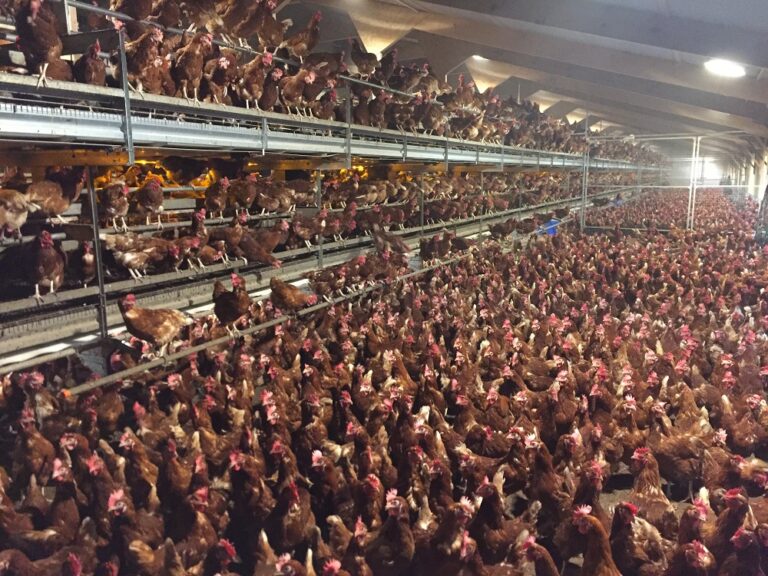Producers looking to extend the laying cycle, while maintaining the production of high-quality eggs, are being encouraged to take a proactive approach to gut health and nutrition in order to maximise the genetic potential of their birds and improve their bottom line.
Harriet Smith, Alltech’s poultry coordinator, explains the industry is pushing for an 80-week laying cycle to satisfy retailer demand and help producers improve their return on investment of each flock. However, to sustain quality egg production beyond 40-50 weeks, the point of natural decline, producers should focus on the role of gut health and nutrition in supporting bird performance.
“As a starting point, producers should look to regularly measure and monitor eggshell strength, to help inform gut health management and nutritional strategies,” says Smith.
Measuring eggshell strength
Eggshell strength is a fundamental aspect of egg quality, and in light of this, Alltech has invested in a portable eggshell force reader that will allow staff to work closely with producers across the UK to measure eggshell strength on-farm.
“The device works by applying gradual force to an egg until it cracks, measuring and recording the force required to break the shell,” Smith explains.
“Eggshell strength does vary depending on the age and breed of the bird. For example, when birds come into lay, the average target eggshell strength is around 5KgF (kilogram of force). But, as they get older and eggshell strength naturally declines, the target strength is reduced to around 4KgF.
“With this in mind, when we’re measuring and monitoring eggshell strength on-farm, any results that fall below the average eggshell strength for the bird’s age and breed suggest that there might be an underlying issue. At this point, we’ll work closely with the producer to identify the potential cause and provide a practical solution to help minimise the risk of increased seconds.”
Smith highlights that in many instances, improvements in gut health and nutrition will enhance eggshell quality. “Improving gut health, and the structure of the gut wall will increase the absorption of vital nutrients that support bird health and production, as well as egg quality,” she says.
“For this reason, we often recommend including a yeast-based product, such as Actigen, in the feed. Actigen is extracted from the inner cell wall of a specific yeast strain produced by Alltech, and reduces challenges to gut function and absorption, by promoting the colonisation of beneficial gut microflora. This supports better feed utilisation and performance.”
Alongside good gut health, Smith notes the importance of optimum mineral nutrition in improving egg quality, and in particular eggshell strength.
“Calcium and magnesium are key components of eggshell formation,” she explains. “But many new studies also show that trace minerals such as copper (Cu), iron (Fe), manganese (Mn) and zinc (Zn) are equally important in maximising eggshell quality.
“However, the form in which they are supplied is key. Chelated organic minerals, such as Bioplex and Sel-Plex, have increased bioavailability compared to their inorganic counterparts, meaning they’re easier to absorb and utilise. They’re best used in a combined mineral pack as a total replacement for, or in addition to, inorganic minerals,” she says.
This claim is reinforced by data collected by Alltech, which has now tested around 15,000 eggs, which is representative of around five million birds.
“As you can see from the data, when incorporating the mineral pack into feed, eggshell strength has been significantly higher between 20-80 weeks, compared to rations with just inorganic minerals. Even though eggshell strength declined over time, it was maintained above the UK standard of 4KgF until 80 weeks, reinforcing the important role of gut health and nutrition.”
Harriet notes that, while there is a cost implication to incorporating the mineral pack into the diet. However, the return on investment is worthwhile.
“For example, by incorporating the mineral pack, producers with a 32,000-bird laying site can save £5 per day, for every one-percent reduction in seconds, which equates to £1,120 per year,” she says.
Nigel Roberts, from Mill Farm Eggs in Pen-Y-Bont, Shropshire, explains that he introduced Actigen and the mineral pack into the ration for his two free-range laying sites over just 12 months ago. With medium prices dropping wanted to improve eggshell quality so he could sustainably produce large eggs to secure a premium price.
“Following discussions with Harriet, I decided to take a proactive approach to managing eggshell strength, as I felt making improvements in this area could help future-proof our business in a changing market,” says Roberts.
“I incorporated Actigen, and the mineral pack, into the feed as soon as the birds arrived on farm. We’ve been monitoring eggshell strength throughout lay and to date, we’ve seen considerable improvements with shell strength sustained for longer .”
“I believe the improvements are down to enhanced gut health and nutrition. It’s certainly been a cost-effective investment, with my production levels at 90% at 58 weeks, and my seconds at just 3%,” he adds.


